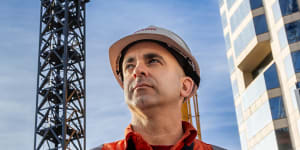
Crane operators like Dom Anthony often have to climb over 30 metres to their cabin.Jonathan Cohen
6am:I wake at 4am to be on-site by 5.30am for a 6am start. After a pre-start meeting with the project team,the crane crew gathers to discuss our plans.
Our crew includes a crane operator and two dogmen (responsible for slinging loads and directing the crane operator) – one on street level and another on the top deck of the building structure – and if it’s a busy day we might have an additional crew member so that we can rotate roles during the day.
You have to train as a dogman or a rigger before you do additional training to gain your licence to operate a crane. The relationship between the operator and dogman is like two bodies and minds working as one. When I’m operating the crane,I can’t always see what’s below,so I rely on the dogmen to be my eyes on everything I can’t see.
6.30am:Some projects have hoists to take you to the cabin,which means I’ll only have to climb to a maximum of 30 metres. But if there’s no hoist,it takes five to 10 minutes to climb to the top. It’s a good way of staying fit!
When you are operating the crane you spend most of the day sitting,but when you are dogging you are on your feet all day. In the cabin,the first thing I do is the pre-start checks of the crane. It’s the most important task I undertake. There’s a plan for every lift,and it’s the responsibility of the operator to make sure the task is executed safely.
We probably do an average of 60 to 100 lifts in a standard 10-hour shift. Every lift is different in its own way. Marr’s fleet includes the largest-capacity tower cranes in the world,so we are lifting anything from small lifts of 100 kilograms up to building materials and equipment such as tunnel boring machine (TBM) components weighing up to 250 tonnes,often in busy urban environments.
The cranes have the latest technology and safety features,including anti-collision and fire suppression systems,and load management indicators to ensure that we don’t overload the crane,but we still need to be hypervigilant about factors such as traffic,weather conditions,people,buildings and other equipment.
9:30am:In an average shift we have a morning and afternoon break,as well as 30 minutes for lunch. A lot of the cabins have fridges and microwaves,but if you need the bathroom you have to climb back down the crane.
If there’s one certainty in construction,it’s that things change. Bad weather and unforeseen events are par for the course. For example,if a concrete pump breaks down,the crane will need to take over to complete the concrete pour on top of the lifts planned for the day.
One of the most challenging parts of the job is dealing with the different personalities and changing schedules on a construction site. The best crane operators tend to have a calm,level-headed temperament.
3pm:Before we knock off we pack up the crane,remove chains and rigging,and weathervane the crane to allow it to move with the wind.
4.30pm:A standard 10-hour shift will usually finish around 4.30pm,but there’s often opportunity for overtime. The money is great,but I’d say the two things people least understand about what we do is the risk and the hours we put in.
We often work six days a week,but it’s rewarding work and there’s nothing else I’d rather be doing.
The Business Briefing newsletter delivers major stories,exclusive coverage and expert opinion..